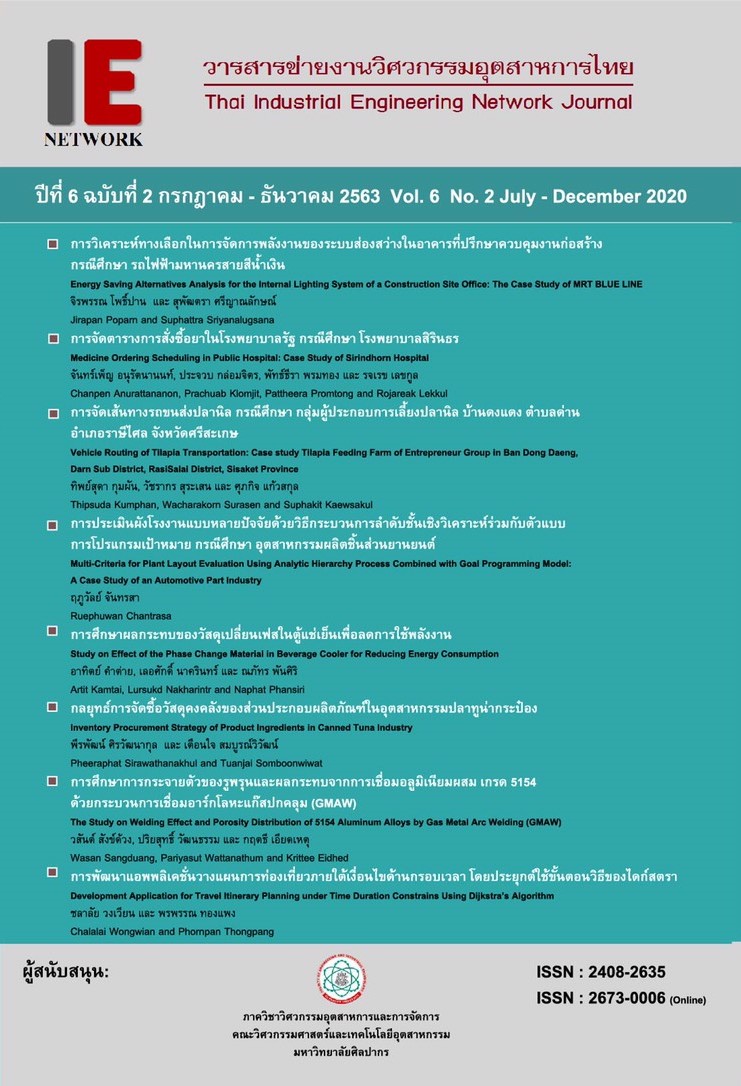Energy Saving Alternatives Analysis for the Internal Lighting System of a Construction Site Office: The Case Study of MRT BLUE LINE
Main Article Content
Abstract
This research aims to analyze the alternatives of using different internal light bulb system in a construction site office over a long construction period. The case study under investigated was the consultant office building for the MRT BLUE LINE extension project for the Hua Lamphong - Bang Khae and Bang Sue - Tha Phra sections. The research method is Cost Effectiveness Analysis to identify the incoming of project and apply the Net Present Value (NPV), Playback Period analysis and Internal Rate of Return (IRR) to compare between alternatives of changing the lighting system to new LED technology lamps from the current T8 light bulbs. The analysis covers three building areas: the central, office and external space of the site office building. The research found that the proposed alternative of changing to LED bulb has a payback period of 2.47 years in the office area, 1.39 years in the common area and 1.59 years in the external area. The return on investment based on an eight-year analysis include the discount rate vale (6.99%) is 60,822.48 baht and Internal Rate of Return (IRR) is 35.99%. As a result, it is feasible to invest in the new alternative of LED technology lamps for this site’s office building. In addition, this alternative complies with the government policy of energy conservation.
Article Details
บทความ ข้อมูล เนื้อหา รูปภาพ ฯลฯ ที่ได้รับการตีพิมพ์ในวารสารฯ ถือเป็นลิขสิทธิ์ของวารสารฯ หากบุคคลหรือหน่วยงานใดต้องการนำทั้งหมดหรือส่วนหนึ่งส่วนใดไปเผยแพร่ต่อหรือเพื่อกระทำการใดๆ จะได้รับอนุญาต แต่ห้ามนำไปใช้เพื่่อประโยชน์ทางธุรกิจ และห้ามดัดแปลง
References
สำนักงานนโยบายและแผนพลังงาน (สนพ.) กระทรวงพลังงาน. พระราชบัญญัติการส่งเสริมการอนุรักษ์พลังงาน (ฉบับที่ 2) พ.ศ. 2550. [เข้าถึงเมื่อ 13 ก.พ. 2563]. เข้าถึงได้จาก: http://www.eppo.go.th/index.php/th/eppo-intranet/item/704-act2550
พรรณชลัท สุริโยธิน. LED ศักยภาพความสดใสของแสงและสี ที่ต้องพิสูจน์. วารสารวิชาการ คณะสถาปัตยกรรมศาสตร์ จุฬาลงกรณ์มหาวิทยาลัย 2554;60:11-24.
หทัยชนก หมื่นกล้า. พลังหลอดไฟ LED (Light emitting diode). วารสารวิทยาศาสตร์และเทคโนโลยี มหาวิทยาลัยราชภัฏนครสวรรค์ 2556;5:36-40
Joint Research Center. Status of LED-Lighting world market in 2017 [Internet]. 2020. Available form: https://e3p.jrc.ec.europa.eu/publications/status-led-lighting-world-market-2017
การไฟฟ้าฝ่ายผลิตแห่งประเทศไทย (กฟผ.). LED Expo Thailand 2013 [อินเตอร์เน็ต]. 2563 [เข้าถึงเมื่อ15 ก.พ. 2563]. เข้าถึงได้จาก: https://www.thailandexhibition.com/News/6399
Khan N, Abas N. Comparative study of energy saving light sources. Renewable and Sustainable Energy Reviews. 2011;15:296-309.
ชัชชัย จันทะสีลา. การศึกษาเพื่อหาแนวทางในการประหยัดพลังงานไฟฟ้าสำหรับสถานพยาบาล กรณีศึกษาอาคารสิรินทรโรงพยาบาลขอนแก่น. [วิทยานิพนธ์ปริญญามหาบัณฑิต สาขาวิชาครุศาสตร์อุตสาหกรรมและเทคโนโลยี]. กรุงเทพฯ: มหาวิทยาลัยเทคโนโลยีพระจอมเก้าธนบุรี; 2559.
เสกสันต์ พันธุ์บุญมี. การจัดการพลังงานไฟฟ้า : กรณีศึกษาโรงพยาบาลเลิดสิน. [วิทยานิพนธ์วิศวกรรมศาสตรมหาบัณฑิต สาขาพลังงานสิ่งแวดล้อมและพัสดุ]. กรุงเทพฯ: มหาวิทยาลัยเทคโนโลยีพระจอมเกล้าธนบุรี; 2559.
ชิดชัย ชูเชิด. การศึกษาการลงทุนในการเอาหลอดประหยัดพลังงานชนิด T5 ทดแทนหลอดชนิด T8: กรณีศึกษาอาคารส่งเสริมสุขภาพ.[วิทยานิพนธ์วิศวกรรมศาสตรมหาบัณฑิต สาขาวิชาการจัดการเทคโนโลยีในอาคาร]. กรุงเทพฯ: มหาวิทยาลัยธุรกิจบัณฑิตย์; 2555.


